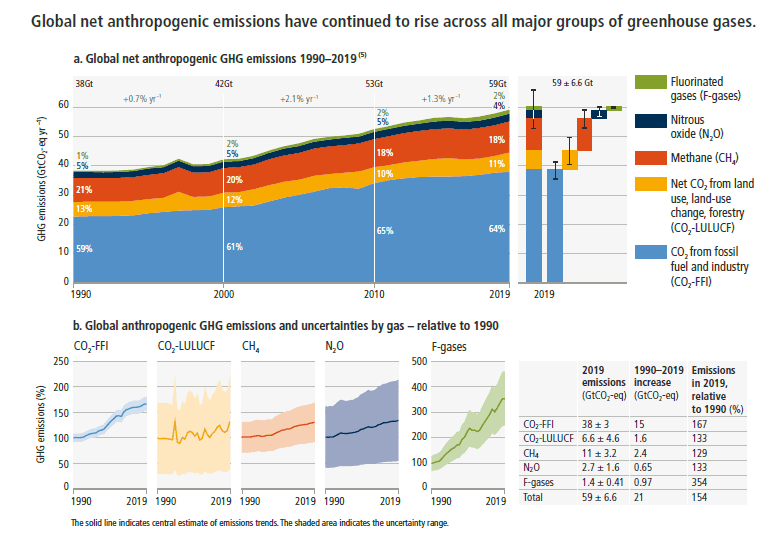Figure: SPM.1
Figure SPM.1: Global net anthropogenic GHG emissions (GtCO2-eq yr-1) 1990–2019 Global net anthropogenic GHG emissions include CO2 from fossil fuel combustion and industrial processes (CO2-FFI); net CO2 from land use, land use change and forestry (CO2-LULUCF)8; methane (CH4); nitrous oxide (N2O); fluorinated gases (HFCs; PFCs, SF6, NF3).5
Panel a shows aggregate annual global net anthropogenic GHG emissions by groups of gases from 1990 to 2019 reported in GtCO2-eq converted based on global warming potentials with a 100-year time horizon (GWP100-AR6) from the IPCC Sixth Assessment Report Working Group I (Chapter 7). The fraction of global emissions for each gas is shown 1990, 2000, 2010, 2019; as well as the aggregate average annual growth rate between these decades. At the right side of Panel a, GHG emissions in 2019 are broken down into individual components with the associated uncertainties [90% confidence interval] indicated by the error bars: CO2 FFI ±8%, CO2-LULUCF ±70%, CH4 ±30%, N2O ±60%, F-gases ±30%, GHG ±11%. Uncertainties in GHG emissions are assessed in the Supplementary Material to Chapter 2. The single year peak of emissions in 1997 was due to higher CO2-LULUCF emissions from a forest and peat fire event in South East Asia.
Panel b shows global anthropogenic CO2-FFI, net CO2-LULUCF, CH4, N2O and fluorinated gas emissions individually for the period 1990–2019, normalised relative to 100 in 1990. Note the different scale for the included fluorinated gas emissions compared to other gases, highlighting its rapid growth from a low base. Shaded areas indicate the uncertainty range. Uncertainty ranges as shown here are specific for individual groups of greenhouse gases and cannot be compared. The table shows the central estimate for: absolute emissions in 2019, the absolute change in emissions between 1990 and 2019, and emissions in 2019 expressed as a percentage of 1990 emissions. {2.2, Figure 2.5, Figure TS.2, Chapter 2 SM}
[FOOTNOTE 5]: Net GHG emissions in this report refer to releases of greenhouse gases from anthropogenic sources minus removals by anthropogenic sinks, for those species of gases that are reported under the common reporting format of the United Nations Framework Convention on Climate Change (UNFCCC): CO2 from fossil fuel combustion and industrial processes (CO2-FFI); net CO2 emissions from land use, land use change and forestry (CO2-LULUCF); methane (CH4); nitrous oxide (N2O); and fluorinated gases (F-gases) comprising hydrofluorocarbons (HFCs), perfluorocarbons (PFCs), sulphur hexafluoride (SF6) as well as nitrogen trifluoride (NF3). Different datasets for GHG emissions exist, with varying time horizons and coverage of sectors and gases, including some that go back to 1850. In this report, GHG emissions are assessed from 1990, and CO2 sometimes also from 1850. Reasons for this include data availability and robustness, scope of the assessed literature, and the differing warming impacts of non-CO2 gases over time.
[FOOTNOTE 8]: Global databases make different choices about which emissions and removals occurring on land are considered anthropogenic. Currently, net CO2 fluxes from land reported by global book-keeping models used here are estimated to be about ~5.5 GtCO2 yr-1 higher than the aggregate global net emissions based on national GHG inventories. This difference, which has been considered in the literature, mainly reflects differences in how anthropogenic forest sinks and areas of managed land are defined. Other reasons for this difference, which are more difficult to quantify, can arise from the limited representation of land management in global models and varying levels of accuracy and completeness of estimated LULUCF fluxes in national GHG inventories. Neither method is inherently preferable. Even when the same methodological approach is applied, the large uncertainty of CO2-LULUCF emissions can lead to substantial revisions to estimated emissions. {Cross-Chapter Box 3 in Chapter 3, 7.2, SRCCL SPM A.3.3}
